|
|
|
|
|
|
|
|
|
|
"Imperial German Colonial and Overseas Troops 1885-1918"
by Alessandro De Quesada and Chris Dale, illustrated by Steven Walsh
(Published by Osprey Men-at-Arms MAA490)
As an author I shouldn't review my own
work but I
do think that its fair to say that this is a very good introduction to the topic. The limitations
of a small paperback meant that it was not possible to go into too much
detail but I do believe that the basics (and some obscure topics such as the
Chinese Polizeitruppe and Reservist uniforms in the different colonies) are
covered. The artwork by Stephen Walsh is far better than the originals on this
website and that alone is worth the small cover price. As usual thanks to the
many contributors to this website for help on this book particularly in this
case to Arne Schöfert, Joe Robinson and Karsten Herzogenrath. Also a big thank you to Martin
Windrow from Osprey who made the book possible.
|
|
|
|
|
|
|
|
|
|
|
|
|
|
|
|
"The
German Colonial
Troops 1889-1918" by
Jürgen
Kraus and Thomas Müller
(Published by
Verlag Militaria in English or German)
This is a superbly researched and illustrated record
of Germany's colonial troops. It begins with the first colonisation
project of Emperor Charles V in the 16th Century, but focuses on the
major years between 1889 and 1919. The majority of the book
describes and illustrates in wonderful detail the clothing and
equipment of the Schutztruppen.
The book illustrates uniforms,
tropical helmets, caps, equipment, and much more besides in great
detail. The book also includes much information about the German
troops that served in East Asia from 1900. Uniform-wise, there are
many interesting details covered, for instance the field grey winter
and summer uniforms issued only to the East Asian troops between
1901 and 1909. This is an absolute must for uniform enthusiasts.
Review by
Helion Military Booksellers |
|
|
|
|
|
|
|
|
|
|
|
|
|
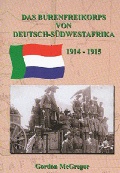
Available at
Namibiana |
"Das Burenfreikorps von
Deutsch-Südwestafrika 1914-1915" by
Gordon McGregor
(Published by Namibiana
in German)
This is one of those
beautiful books that fully covers a topic leaving no stone unturned.
It covers the story of the Boers who formed a volunteer unit to
fight alongside the Schutztruppe in South West Africa in 1914. It
studies their historical background, formation, recruitment, the
few actions they took part in and their eventual disbandment. The
topic of their uniforms is also covered and there are plenty of
photographs to accompany the text. Most of the information is
unavailable in print anywhere else so this book is to date, the
definitive account of the South African Free Corps. |
|
|
|
|
|
|
|
|
|
|
|
|
|
|
|
"Der Reichskolonialbund und seine kolonialrevisionistische
Propagandatätigkeit zwischen, 1933 und 1943"
by
Arne Schöfert
(Published by König
in German)
This book tells the
story of the
Reichskolonialbund, the German Colonial League and their revisionist
propaganda under the Third Reich. It focuses on the two large
colonial exhibitions staged in Dresden in 1939 and Vienna in 1940 to
encourage public awareness of the lost colonies. Almost every page
of the book has photos of the exhibitions and their organisers along
with Nazi colonial propaganda posters, postcards, stamps badges and
souvenirs. Of special interest to me was the uniform details of
the Schutztruppe veterans of the Deutschen Kolonialkriegerbundes, DKKB.
An excellent and highly recommended book for anyone studying the
after effects of German colonialism and Third Reich History.
|
|
|
|
|
|
|
|
|
|
|
|
|
|
|
|
"Die deutschen Marinen 1818-1918: Organisation, Uniformierung,
Bewaffnung und Ausrüstung"
by Rolf
Noeske and Claus P. Stefanski
(Published by Verlag Militaria
in German)
These two volumes cover the organisation,
uniforms and equipment of the Royal Prussian and later Imperial
German Navy. It includes the Marine Infantry and all branches of the
German navy up to and during the First World War. For my personal
interest the book has studies on the overseas deployments of naval
units in Africa, China and Skutari. I have never seen a book go into
quite so much depth on this topic and as such it is highly
recommended for anyone with an interest in the Imperial German Navy
and its predecessors. |
|
|
|
|
|
|
|
|
|
|
|
|
|
|
|
"A
Clash of Empires- The South Wales Borderers
at Tsingtao 1914" by John Dixon
(Published by Bridge Books in
English)
This book primarily focuses on the British contingent
at the Siege of Tsingtao, the
2nd Battalion of the South Wales Borderers and
the relations with their Japanese allies which were not always
harmonious and were based on a lack of understanding of each others'
languages, customs and military training. Although the book does not
describe the German side in detail, it is highly recommended as the
only English language study of the action and it contains many
photos and eyewitness accounts of the Siege of Tsingtao. |
|
|
|
|
|
|
|
|
|
|
|
|
|
|
|
"Rivals Of The Raj:
Non-British Colonial Armies in Asia 1497-1941"
written and illustrated by Peter Abbott
(published by Foundry
in English)
The title of this book excludes British colonial forces in
Asia. This is just as well as the soldiers of the British Empire have been
covered so many times in the English language that there would
scarcely be anything new to write about them and they would just fill up a lot
of page space while I personally am more interested in the lesser known colonial
armies. This volume instead concentrates mainly on the French, Portuguese,
Spanish, Dutch and German armies in Asia. There is a wealth of
previously unpublished information on
these troops. But as with the authors other books (see also the companion volume
to this one- "Colonial Armies:
Africa" and Osprey's "Armies in East Africa",
both reviewed elsewhere on this page) the real treat
here is his coverage of previously unknown armies. Austria-Hungary, Denmark,
Belgium, Italy and Sweden may not be the first countries that come to mind when
thinking of the colonial era in Asia but they all played their part and this
book is the first I've seen to recognise that part with new research, excellent
illustrations and full histories from the 15th Century to the 20th.
|
|
|
|
|
|
|
|
|
|
|
|
|
|
|
|
"Rebellion in der Südsee"
by Thomas Morlang
(Published by
CH Links in German)This is the
definitive book on the Sokehs Rebellion on Ponape in German New
Guinea 1910-11, perhaps the only serious recent study. As with
Morlang's previous work on "Askari und Fita-Fita" the amount of
research done is staggering. The book first looks at German rule on
the Pacific Islands and the interaction of the islanders with their
colonial rulers. The rebellion itself and the German efforts to
crush it are described in detail using previously unpublished
eyewitness accounts. Lastly the effects of the rebellion on the
Sokehs and on German rule are examined with a look at how the
rebellion is remembered in modern Ponapean culture. Throughout the
book uses period photographs and several maps (including some
showing the battlefield around the Sokehs stronghold) many of which
are previously unpublished and those that have been seen before
often have new captions identifying the individuals in them.
Absolutely essential reading for those interested in this small
campaign. |
|
|
|
|
|
|
|
|
|
|
|
|
|
|
|
"Uniforms of the German Colonial Troops 1884-1918"
by Charles Woolley
(Published by
Schiffer in English)
This book is based around reprints of
period illustrated plates mostly by well known and respected artists
such as Knötel, Pietsch, Henckel, Becker and Ruhl. It also includes
some artists work that I've never come across before such as
Friedrich Schirmer, Anton Hoffman and some more recent artists work
notably Tradition's RJ Marrion.
All the plates are printed in full
colour (unless the originals were monochrome, of course) and much
larger and clearer than I've seen before giving a very pleasing
appearance to the book. As a bonus the last chapter shows many
previously unpublished photographs of the III. Seebataillon in
Tsingtao. |
|
|
|
|
|
|
|
|
|
|
|
|
|
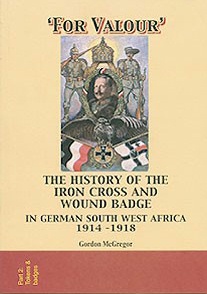
Available at
Namibiana |
"For Valour"
by Gordon McGregor
(Published by Namibia Scientific Society
in English)
The subtitle, "The History of the Iron Cross and
Wound Badge in German South West Africa 1914-1918" aptly describes
the never previously studied topic of this book. This is one of
those great books that once you've read it you have no more
questions to ask yourself on the subject matter. Everything you
could want to know about the so-called Hildegard Order is described.
It starts with the origins of the Iron Cross in South West Africa up
to the recipients claims for the award after the war. A final
chapter goes into post war awards of the Wound Badge to the
Schutztruppe. Lists of awardees are included as well as photographs
of the awards themselves and their documents. A great piece of
research, the topic is covered! |
|
|
|
|
|
|
|
|
|
|
|
|
|
|
|
"Die Mützenbänder der Deutschen Marine
1815 - 1918" by Bernd Wedeking and
Marcus Bodeux
(Published by
VD Medien
in German)
Something that used to upset me greatly was small
books trying to cover big topics. A tiny handbook on "Military
Uniforms of the World" which might have one illustration of a
Schutztruppe Reiter and a small paragraph about the German Colonies,
would always leave me frustrated with additional questions. Who?
Where? Why? And what was the NCOs ranks insignia? This book by
complete contrast is a big book, on a small subject. Hence they have
illustrated or photographed every single cap band ever used by the
imperial navy as well as describing every slight variation in its
use or award. That's over 1200 illustrations! As well as the tallies
used by ships' crews it helpfully covers those worn by every small
sub-unit of the Imperial navy (and the Prussian navy before it). Of
special interest for those interested in Germany's overseas
servicemen are sections on the Kiautschou naval batteries and
the ships in Ottoman service during the First World War. If you've ever been curious about Prussian or Imperial
German naval cap bands this is the book for you. |
|
|
|
|
|
|
|
|
|
|
|
|
|
|
|
"Die Schlacht um Kiautschou"
by Manfred Neugebauer
(Published by Melchior in German)This book covers
the siege of Tsingtao in 1914, mainly from the German perspective.
It is very well researched and illustrated with maps, photographs
and diagrams of the fortifications. It documents the siege with full
details of the supply problems, the skirmishes, bombardments and the
final surrender of the German garrison.
In the absence of any
similar study of the campaign in the English language I would
recommend this book to anyone learning or with only some basic
German (like myself) as it is very clearly written in short,
easily-digestible paragraphs. A unique book on a fascinating topic. |
|
|
|
|
|
|
|
|
|
|
|
|
|
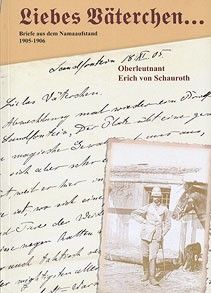
Avaliable from Namibiana |
"Liebes
Väterchen" by Oberleutnant Erich von Schauroth
(Published by Namibiana in German)This is a
personal account written by a Schutztruppe officer serving under
Ludwig von Estorff in the Herero and Nama Rebellions in German South
West Africa between 1905-06. As a first hand account it is
fascinating for historians of the period, especially as it details
the attempts to track down the rebels, Cornelius and Morenga. What
makes the book all the more interesting is that it is written not
for publication but in the form of a series of letters from the
author to his father back in Germany. The publishers,
Namibiana,
specialise in books on Africa and the German colonies including many
unpublished memoirs such as this. Their catalogue of books is highly
recommended. |
|
|
|
|
|
|
|
|
|
|
|
|
|
|
|
"Unter dem Kreuz des Südens: Auf Spuren der Kaiserlichen Landespolizei von
Deutsch-Südwestafrika"
by S Schepp
(Self Published in German)
This recently published book is the definitive study of the
Landespolizei in German South West Africa. As you would expect it
covers the
history, organisation, uniforms and equipment of the Landespolizei
but what it also does is bring these extensively researched facts
and figures to life by winding it around the life stories of many of
the policemen themselves.
The author has travelled the world to find
descendants of the Landespolizei to find their own personal stories.
This touch, as well as the hundreds of previously unpublished facts,
photographs and illustrations makes this book a must for all those
interested in the German colonies. |
|
|
|
|
|
|
|
|
|
|
|
|
|
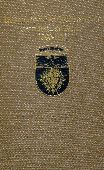
Available from Battery Press |
"German
Schutztruppe in East Africa 1889-1911" by Ernst Nigmann
translated by Robert E Dohrenwend (Published
by Battery Press in English)
In 1910 Hauptmann Ernst Nigmann was commissioned to write a history
of the Schutztruppe in German East Africa. Nigmann was able to draw
on his own personal experience as a front line Schutztruppe officer,
interviews with other officers and full access to German archives
for his work. The result, published in English for the first time
here, is a very comprehensive study, describing their formation as
the Wissmanntruppe, each stage of their development and organisation
up until 1911and every single action they were involved in during
that period. Various appendices deal with the Polizeitruppe, rank
lists and casualty lists going into the most minute detail, such as
"16 October 1905. Fighting on the Lijungeberg: Chief Surgeon Dr
Stolowski, graze on the left hand". A more complete book would be
difficult to imagine. |
|
|
|
|
|
|
|
|
|
|
|
|
|
|
|
"Colonial
Armies: Africa 1850 to 1918" written and illustrated by Peter
Abbott
(Published by
Foundry in English)
This has to be the most highly recommended
volume so far printed in the English language for those generally interested
in the colonial armies of Africa. The author has collated years of
research into the archives of Europe and Africa to describe the
armies of Britain, France, Germany, Spain, Italy, Portugal and
Belgium in 19th century Africa.
Each power has a section set aside
for the description of its campaigns, troops and uniforms with
contemporary illustrations added to by numerous excellent black and
white uniform illustrations. Much of the information has not
previously been available in the English language. A second volume
covering colonial armies in Asia is planned for future release. |
|
|
|
|
|
|
|
|
|
|
|
|
|
|
|
"Askari und Fitafita - Farbiger Söldner
in den deutschen Kolonien" by
Thomas Morlang
(Published by
CH Links in German) While most books on the colonies inevitably look at them from a
Euro-centric angle, this very well researched study is exceptionally
interesting in that it looks at the African and Asian troops who
served under German colonial rule.
As well as chapters on each
colony describing the history of its locally recruited soldiers and
their experience, Morlang has also included many period photographs
and biographies of individual soldiers and thus brought them vividly
to life. |
|
|
|
|
|
|
|
|
|
|
|
|
|
|
|
"My Reminiscences of East Africa" by General Paul von
Lettow-Vorbeck
(Published by Battery Press in English)
As you would expect from the commander in the field, von
Lettow-Vorbeck knows an awful lot about the campaign. In this book
he tells the story of the First World War in East Africa from the
German perspective.
He seems to paint quite an objective picture of
events, admitting his own mistakes, heaping praise on his junior
officers and not appearing too judgemental on his opponents
consistently poor performance. He goes into some detail on the
battles, German forces involved and their relative weaknesses and
supply problems.
Many more recent authors may have studied the
campaign from all angles but none can have the same insight as von
Lettow-Vorbeck. |
|
|
|
|
|
|
|
|
|
|
|
|
|
|
|
"The Battle of Tanga 1914"
by Ross Anderson
(Published by
Tempus in English)
A great study of the Battle of Tanga from original source documents
with some good photos not only of the personalities and opposing
armies but also of Tanga itself and the battlefields from various
angles which help to build up a good mental picture of the battle.
The book
assesses the forces and leaders involved and gives a good account of
the confusion in East Africa at the start of the war before going on to
describe the landings and action in detail. Although covering the
German side too the book does mainly focus on the catalogue of
compounded British errors. Indispensable for anyone interested in
the First World War in East Africa. |
|
| |
|
|
| |
|
|
|
|
|
|
|
|
"Armies in East Africa
1914-18" by Peter Abbott, illustrated by Raffaele Ruggeri
(Published by
Osprey Men at Arms in English)
An excellent starter book for all wargamers and enthusiasts of the
First World War in East Africa. It covers the history of the campaigns in East
Africa with backgrounds, organisations and uniforms for all the
armies involved.
The sections on the previously ignored Portuguese
and Belgian forces deserve special credit as do the many photos and
luscious illustrations.
My only real complaint would be as with many
Osprey books, it's just too short! |
|
| |
|
|
| |
|
|
|
|
|
|
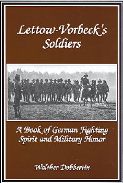
Available from Battery Press |
"Lettow-Vorbeck's Soldiers" by Walther Dobbertin
(Published by Battery Press with captions in English and German)
"Walther Dobbertin was a commercial photographer in German East
Africa prior to World War I. When all German men were mobilized in
August 1914 to defend the colony, Dobbertin became, in effect, the
only combat photographer on the German side. He performed this
function until his own capture in 1916."
This book is packed from start to finish with 120 excellent
photographs of the Schutztruppe in German East Africa taken in the
first two years of the war with German and English captions. Some of
the photos have been seen before, but many were new to me and all
are printed with clarity. This book is a must for anyone interested
in the uniforms of German East Africa during the Great War. |
|
|
|
|
|
|
|
|
|
|
|
|
|
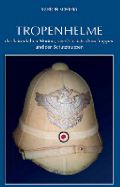
Available from the
Deutsche
Gesellschaft für Heereskunde |
"Tropenhelme der kaiserliche Marine, der
Ostasiatischen Truppen und der Schutztruppen"
by Ulrich Schiers
(Published by the
Deutsche Gesellschaft für Heereskunde in German)
This is an amazing study into the subject of tropical helmets worn
by Germany's overseas troops. It describes the development and
changes in helmet design for the imperial navy, East Asian troops
and Schutztruppe as the title says but also for the Polizeitruppe,
colonial officials, imperial entourage, governors, consuls and just
about every uniformed German abroad.
With colour photos of over 40
existing tropical helmets and black and white period photos too,
this book should also be of great interest to non-German speakers. |
|
|
|
|
|
|
|
|
|
|
|
|
|
|
|
"Imperial German Field
Uniforms and Equipment 1907-1918 Vol 3" by Johan
Somers
(Published by
Schiffer in English)
In the third volume of his very detailed study of German uniforms
and equipment, Somers devotes 232 pages to Germany's colonial and
overseas forces. The text describes the uniforms in quite some
detail and is very well researched, while the bulk of the space is
given to black and white photographs from the period (many have
never been seen in print before) and colour photographs of surviving
militaria (some of which are from the Doppler collection also seen
on this website- but it's still good to see them printed out large,
in colour and on quality paper).
Other non-colonial subjects covered
in this volume are the German Landsturm, cyclists, horse equipment
and Ersatz headgear worn on European fronts in the First World War.
All in all an excellent and unique book- and Somers has been kind
enough to quote this website as a source. |
|
|
|
|
|
|
|
|
|
|
|
|
|
|
|
"Uniforms of the German Soldier - 1870 to the
End of World War One" by Alejandro M. De
Quesada
(Published by Greenhill in
English)
This is a large collection of photographs of the German army
throughout the imperial period, many of which have not been seen in
print before.
What makes this book particularly interesting are the
23 pages of colonial photographs, including the Schutztruppe,
Seebataillone, Asienkorps, East Asian troops and even a couple of
Chinese auxiliary troops. As a bonus feature several pages of
colonial illustrations by Moritz Ruhl have been added in the back.
|
|
|
|
|
|
|
|
|
|
|
|
|
|
|
|
"Military Sun Helmets of the World"
by Peter Suciu with Stuart Bates
(Published by Scuicu/Bates/Service Publications, Ottawa
in English)
I believe this is the first book ever published
to describe the tropical helmets used by the world's military forces
from their first use in the mid-19th Century up to the present day.
It fills a gap in the market very well. Not only are commonly seen
British, German and French helmets covered but also the less well
documented helmets of Belgium, Portugal and Spain. Each country has
its own chapter or section and has its helmets' history, manufacture
and appearance described along with period black and white
photographs and hundreds of colour photographs of surviving helmets,
many of which are from the author's own personal collection. A very
useful and attractive book. The author has also been kind enough to
thank this website for help with German colonial
helmets. See
Military Sun Helmets of the World |
|
|
|
|
|
|
|
|
|
|
|
|
|
|
|
"Imperial German Schutztruppe
1891-1914" by Bruce Bassett Powell
(Published by Uniformology in English)
This is a collection of period German illustrations which have been
touched up with computer graphics to enhance their colour and
detail. It includes illustrations by M. Ruhl, G. Krickel, H. Knötel
and P. Pietsch. While it is great to see these illustrations printed in
colour again, they are not complete collections and some of the
text can be misleading. |
|
|
|
|
|
|
|
|
|
|
|
|
|
|
|
"Battle For the Bundu" by Charles Miller
(Published by MacDonald & Jane's
in English)As far as I know, this was the first modern scholarly treatment, in
English, of the Campaign for East Africa. It is very well-written
and a pretty compelling account that focuses on von Lettow-Vorbeck's
defence of German East Africa and the saga of the
cruiser Königsberg . It does
provide a fairly good background to the German colonization of East
Africa and the subsequent defence of it during WWI. One could say
that it is a pro-German account and it doesn't dwell on the lengthy
resistance of the African states to colonialisation. But, that
aside, once the story moves into WWI, the book is fairly
even-handed. Also, the book covers the naval campaigns on Lake
Tanganyika and Lake Nyassa, which is pretty difficult stuff to get
hold of from any source. Personally, I recommend it and even though
it was one of the first books I read on this subject, it holds up
very well.
Review by David C. Clarke |
|
|
|
|
|
|
|
|
|
|
|
|
|
|
|
"Absolute Destruction: Military Culture and
Practices of War in Imperial Germany" by
Isabel Hull
(Published by
Cornell University Press
in English)
It's well researched and not a bad read. The
author, a professor at Cornell University even had the cooperation
of the von Trotha family in writing the book and had access to
family archives. She also has some interesting quotes from von
Lettow-Vorbeck that I've never seen before.
There is a big
section on the Herero War with the focus on the battle of Waterberg and the aftermath. But it also looks at the German
punitive expeditions following the Boxer Rebellion and the
Maji-Maji Uprising, although more anecdotally. It goes back to
the wars of unification and Franco-Prussian War to show the extent
of Germany's military culture and how this influenced how the
Germans fought their wars through the end of WWI. Very academic,
but still an interesting read.
Review by Greg Gerardi
|
|
|
|
|
|
|
|
|
|
|
|
|
|
|
|
"The Scramble for Africa" by Thomas Packenham
(Published by Abacus
in English)
This book covers the campaigns, revolts and diplomatic entanglements
faced by the various European powers in their scramble for Africa in
the late 19th and early 20th centuries.
It's the perfect
introduction to colonial Africa with chapters on well known
campaigns such as the Anglo-Zulu and Anglo-Boer Wars as well as
lesser known struggles such as the French in Tunisia, the Italians
in Ethiopia and of course the establishment and major rebellions of
the German African colonies. The book is well researched and very readable,
bringing to life the dramas and horrors of European conquest. |
|
|
|
|
|
|
|
|
|
|
|
|
|
|
|
"Escape from England" by Günther Plüschow
(Published by
Ripping
Yarns in English)Plüschow was the only German pilot in Tsingtao in
1914. This book covers his times in Tsingtao and his travels and
escapes as he gets back to Germany via China, America, Gibraltar and
England. Plüschow is a natural storyteller and the book reads like
an adventure with some great first hand accounts of the bombardment
and siege of Tsingtao and his flights over Japanese lines. It's not
a historical study of the battle as such but a thrilling and unique
story all the same. |
|
| |
|
|
| |
|
|
|
|
|
|
|
|
"Blockade and Jungle" by Nis Kock, edited by
Christen P Christensen
(Published by Battery Press in English)
This book is based on the diaries of Nis Kock, one of the Danish
speaking members of the German Navy who sailed through British Naval
blockades under the neutral Danish flag to re-supply the forces of
German East Africa. After a perilous journey there he and the rest
of the crew were stranded and joined the Schutztruppe trekking
across the mountains and jungles with Lettow-Vorbeck for the next
few years. No amount of historical reading can compare with an
eye-witness account of the events such as this, including vivid
descriptions of everyday life and combat on the East African front. |
|
| |
|
|
| |
|
|
|
|
|
|
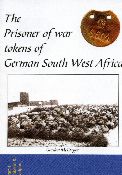
Availiable from
nwg@iafrica.com.na |
"The Prisoner of War Tokens of German South West Africa" by
Gordon McGregor
(Published by Namibia Scientific Society in English)
This small book in both English and German is perfect in its form.
By covering a small topic the author has managed to write a book
covering every detail of that topic- when the tokens were issued,
why the tokens were issued, how the tokens were made, who the tokens
were issued by and to and the serial numbers of different issuing
offices. The book also contains detailed photos of POW tokens and of
POWs and their camps in South West Africa. The author has also
written books on 'The German South West Africa Commemorative Medal
awarded to non-German military personnel', and 'The Native pass
Tokens of German South West Africa' for the same publisher and is
currently writing a book on the history of the Iron Cross
(Hildegard Order) and the Wound Badge in German South West Africa, a
Handbook on the South West Africa Commemorative Medal, The South
African Free Corps and the Ehrenkreuz awarded to Germans still
living in South West Africa in 1934. |
|
|
|
|
|
|
|
|
|
|
|
|
|
|
|
"African Crossroads- Intersections between History
and Anthropology in Cameroon" edited by Ian Fowler and David Zeitlyn
(Published by Berghahn Books in English)This is an academic look at the integration of the people of
Cameroon and particularly those of the Western Grasslands with
European culture, religion and colonialism. It covers many aspects
of life for the Nso, Duala, Bali-Nyonga and Bamum peoples in the
late nineteenth and early twentieth Centuries.
The most interesting
part for me is the final chapter, a study of the history and
reasoning behind the German style uniforms worn by
King Njoya of Bamum's Private
Army by Christraud M. Geary. It is a very informative study
given the limited sources (perhaps the only study of this topic in
any depth) and includes several very rare photographs of the Bamum
soldiers in uniform. |
|
|
|
|
|
|
|
|
|
|
|
|
|
|
|
"Like Hidden Fire" by Peter Hopkirk
(Published by Kondasha in English)This book deals with the complex extensions of the old Great Game
played out in Central Asia during the First World War. It tells the tale of Wassmus' wanderings
in Persia trying to ferment anti-British sentiments, Niedermeyer's
mission to convince the Emir of Afghanistan to join the Central
Powers and also the intrigues and struggle for power in the oil rich
town of Baku on the Black Sea coast.
The book not only sheds light
on and goes into detail about a side of the war never seen before but also reads like a first
class spy thriller, with double agents, lost code books and
murderous cossacks around every corner. |
|
| |
|
|
| |
|
|
|
|
|
|
|
|
"Official History of the War- Military Operations in Togoland and
the Cameroons" by Brigadier General F.J. Moberley
(Published by
Battery Press in English)
This book recounts every step, every skirmish and every moment of
planning of the First World War campaigns in West Africa in detail. It's not a book
for a racy read but if it's day by day facts you want they're all
here. The book is of course strictly a history of the British and
British Empire forces during the conflict (it's interesting to note
that they seem to have as little information as to the whereabouts
or strengths of their French allies as those of their German
opponents) but there's a lot to be gleaned about the German forces
quotes from captured diaries and comments from prisoners. There's also some
black and white photos and big fold out maps for wargamers to
plot their next campaign on. |
|
| |
|
|
| |
|
|
| |
|
|
|
|
"Peking 1900- The Boxer Rebellion" by
Peter Harrington, illustrated by Michael Perry
(Published
by Osprey
Campaign
Series in English)
A very good overall description of the Boxer Rebellion in China.
This book explains the background to the rebellion not only from the
view of the foreign powers but more interestingly from the Chinese
perspective. It then goes on to describe in detail the various
actions of the campaign resulting in the relief of Peking. The book
is packed with black and white contemporary photographs and
illustrations with modern colour illustrated pages too, but my
favourite parts of the book are the many maps of the battles fought
in the rebellion including the Peking legations and the Taku Forts.
As with other Osprey books my only complaint is that all the
different Allied and Chinese troop formations, uniforms and weaponry
cannot be fully described in such a small volume. |
|
| |
|
|
| |
|
|
|
|
|
|
|
|
"Die Deutsche Schutztruppe 1889/1918" by Werner Haupt
(Published by
Dörfler in German)If you're only ever going to buy one book in German I would
thoroughly recommend this one. It answered more questions about the
German Schutztruppe than I knew to ask. It covers their formation,
history, organisation, officer lists and uniforms with additional
sections on the Police forces of Togo, New Guinea and Samoa and well
as the Protectorate of Tsingtao. There's some great photos and a few
colour plates and even though my German isn't very good I enjoyed it
thoroughly. |
|
|
|
|
|
|
|
|
|
|
|
|
|
|
|
"Die Kaiserliche Schutz- und Polizeitruppe für Afrika"
by Reinhard Schneider
(Published by Druffel & Vorwinkel-Verlag in German)...and
if you're only ever going to buy two German books (it gets
contagious) I would
recommend this one too. Similar to Haupt's book in that
it covers the history and uniforms of the Schutztruppe but with less
historical background and
more information on the uniforms. It also has some great colour photographs
of genuine Schutztruppe uniforms and scale model soldiers with some
rare and very interesting black and white photographs from the
period. So even if your German isn't so good there's loads of pictures
to look at! |
|
|
|
|
|